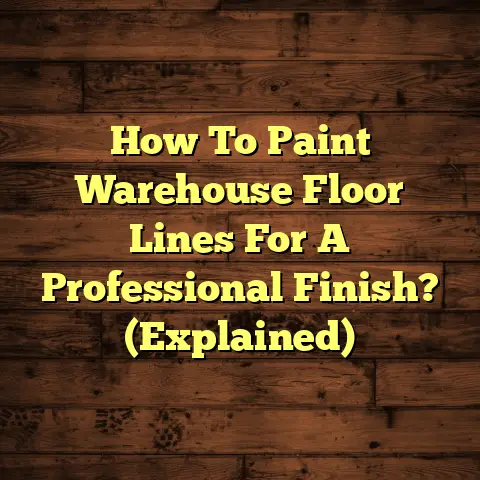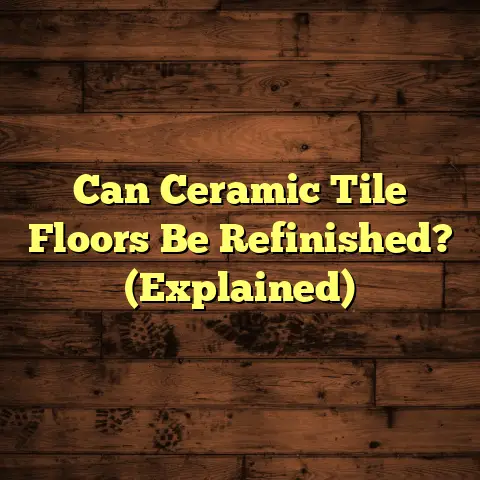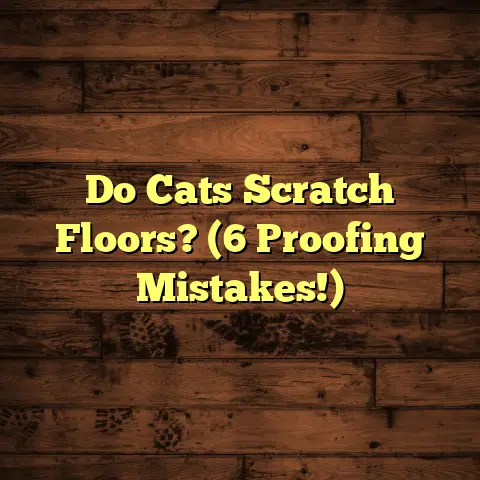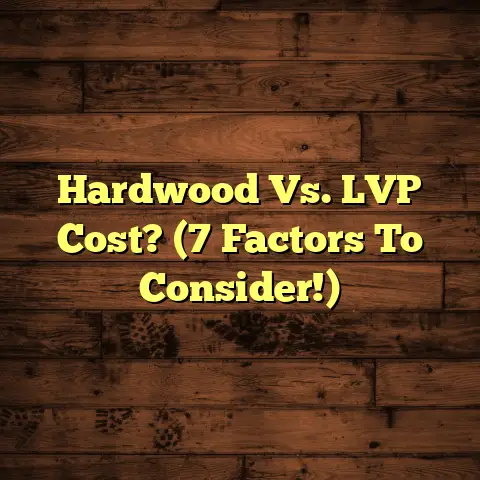Safety Of Gel Pro Mats On Hardwood Floors?
As the leaves change and we settle into fall, I’ve noticed many homeowners shifting their focus to creating cozy and functional spaces.
With the holidays around the corner, kitchens
become the heart of the home.
People are spending
more time cooking and entertaining.
That’s where Gel Pro mats come in!
They’re a
popular choice for adding comfort to those long
hours spent standing.
But, are they safe for your beautiful hardwood
floors?
That’s what I’m here to help you figure
out.
In this article, I’ll dive deep into the world of
Gel Pro mats and hardwood floors.
I’ll walk you
through the potential risks and benefits.
I’ll also share my expert advice on how to use
them safely.
Let’s get started!
Section 1: Understanding Gel Pro Mats
So, what exactly are Gel Pro mats?
Well, think of them as super-cushioned mats
designed for comfort.
They’re typically made with
a gel or foam core.
This provides excellent ergonomic support,
especially when you’re standing for long periods
of time.
I’ve seen them used everywhere.
From home kitchens to commercial workspaces.
They’re a go-to solution for reducing fatigue and
discomfort.
The design is pretty straightforward.
You’ve
got a comfortable top layer, usually made of
rubber or fabric.
Then, there’s the gel or foam core that provides
the cushioning.
Finally, a non-slip backing keeps
the mat in place.
Gel Pro mats have become a staple in many homes
and workplaces over the years.
Their popularity
stems from their ability to make standing more
comfortable.
This is crucial for anyone who spends a lot of
time on their feet.
Believe me, my feet thank me
every day!
Section 2: Characteristics of Hardwood Floors
Now, let’s talk about hardwood floors.
They’re a classic choice for homeowners because of their beauty and durability.
Think oak, maple, cherry – each type has its own unique grain and color variations.
Hardwood floors add warmth and elegance to any
room.
I’ve installed countless hardwood floors
over the years.
I can tell you that they’re an investment that can last for decades with proper care.
But, here’s the thing: hardwood floors are
sensitive to certain conditions.
Moisture is a
big enemy.
Spills need to be cleaned up quickly to prevent
warping or staining.
Scratches are another
concern.
Dragging furniture or wearing shoes with sharp heels can damage the finish.
Maintenance is key to keeping hardwood floors
looking their best.
Regular sweeping or vacuuming
removes dirt and debris.
Occasional mopping with a wood-friendly cleaner
helps maintain the shine.
I always recommend
using a pH-neutral cleaner.
This prevents damage to the finish.
Section 3: Potential Risks of Using Gel Pro Mats
on Hardwood Floors
Okay, let’s get to the heart of the matter: the potential risks of using Gel Pro mats on hardwood floors.
One of the biggest concerns is slippage.
If the mat isn’t properly secured, it can slide
around, especially in high-traffic areas.
This
can be a tripping hazard, which is something
I always warn my clients about.
Another risk is moisture accumulation.
If spills or condensation get trapped beneath the
mat, it can create a breeding ground for mold and
mildew.
This can damage the hardwood floor and
cause unpleasant odors.
Scratches and abrasions are also a possibility.
Dirt and debris can get trapped between the mat
and the floor.
This acts like sandpaper, scratching
the finish over time.
I’ve seen cases where homeowners have had to
refinish their hardwood floors because of damage
caused by mats.
It’s not a pretty sight, or a
cheap fix!
Let me share a quick story.
I once had a client
who used a Gel Pro mat in her kitchen.
She didn’t realize that a small leak under the sink was causing water to seep under the mat.
Over time, the moisture caused the hardwood floor
to warp and discolor.
She ended up having to
replace a large section of the floor.
That’s why it’s so important to be aware of these risks and take precautions.
Section 4: Safety Features of Gel Pro Mats
Now, before you ditch your Gel Pro mat altogether, let’s talk about the safety features they offer.
Many Gel Pro mats come with non-slip backings.
These are designed to grip the floor and prevent
the mat from sliding around.
Weight distribution is another important factor.
Gel Pro mats are designed to distribute your
weight evenly.
This reduces pressure on your
joints and muscles.
Shock absorption is also a key benefit.
The gel
or foam core helps absorb impact.
This can be especially helpful if you’re standing on a hard surface for long periods of time.
Many Gel Pro mats undergo testing to ensure they
meet safety standards.
Look for certifications
like those from the National Floor Safety Institute
(NFSI).
These certifications indicate that the mat has been tested for slip resistance and other safety factors.
I always encourage my clients to read user reviews before buying any type of mat.
This can give you valuable insights into how the mat performs in real-world conditions.
Keep in mind that experiences can vary depending on the type of hardwood floor and the specific Gel Pro mat.
Section 5: Best Practices for Using Gel Pro Mats
on Hardwood Floors
Alright, let’s get down to the nitty-gritty: how to safely use Gel Pro mats on hardwood floors.
First and foremost, make sure the mat is properly
secured.
If the non-slip backing isn’t doing the
trick, consider using rug grippers or double-sided
tape.
These can help keep the mat in place and prevent it from sliding around.
Regular cleaning is essential.
Sweep or vacuum
the mat regularly to remove dirt and debris.
Also, lift the mat periodically to clean the hardwood floor underneath.
This will prevent dirt and moisture from building up.
Speaking of moisture, be extra careful in areas where spills are likely.
Wipe up spills immediately and make sure the floor is completely dry before replacing the mat.
I recommend using a dehumidifier in damp environments to prevent moisture buildup.
It’s also a good idea to monitor the condition of the floor underneath the mat over time.
Check for any signs of discoloration, warping, or
mold growth.
If you notice anything unusual,
remove the mat and address the issue immediately.
When might it be best to avoid using Gel Pro mats altogether?
If you have a very delicate hardwood floor with a fragile finish, it might be best to err on the side of caution.
In these cases, consider using alternative solutions for comfort, such as padded rugs or ergonomic shoe inserts.
Here’s a quick checklist for using Gel Pro mats safely on hardwood floors:
- Secure the mat: Use rug grippers or double-sided tape if needed.
- Clean regularly: Sweep or vacuum the mat and the floor underneath.
- Wipe up spills: Clean up spills immediately and dry the floor thoroughly.
- Monitor for moisture: Check for signs of moisture buildup or mold growth.
- Consider alternatives: If you have a delicate floor, explore other options for comfort.
By following these guidelines, you can enjoy the comfort of Gel Pro mats without damaging your beautiful hardwood floors.
Conclusion
So, there you have it: a comprehensive look at the safety of using Gel Pro mats on hardwood floors.
As I’ve shown you, it’s all about finding the right balance between comfort and safety.
Gel Pro mats can be a great addition to your home, providing ergonomic support and reducing fatigue.
But, it’s important to be aware of the potential risks and take precautions to protect your hardwood floors.
Consider the unique characteristics of your hardwood flooring and your lifestyle needs.
If you have a delicate floor or a high-traffic area, you might need to take extra steps to prevent damage.
The world of flooring solutions is constantly
evolving.
New materials and designs are emerging
all the time.
I’m excited to see what the future holds and how we can continue to create comfortable and safe spaces for our homes.
Thanks for reading!
I hope this article has been
helpful.
If you have any questions, feel free to
reach out.
References
- National Floor Safety Institute (NFSI): https://nfsi.org/
- Hardwood Flooring Association:
(Please note that a general “Hardwood Flooring
Association” is not specific enough to link to
a single authoritative source.
However, organizations like the National Wood Flooring Association (NWFA) are excellent resources.) https://www.nwfa.org/ - Environmental Protection Agency (EPA) – Information on Mold and Moisture: https://www.epa.gov/mold





